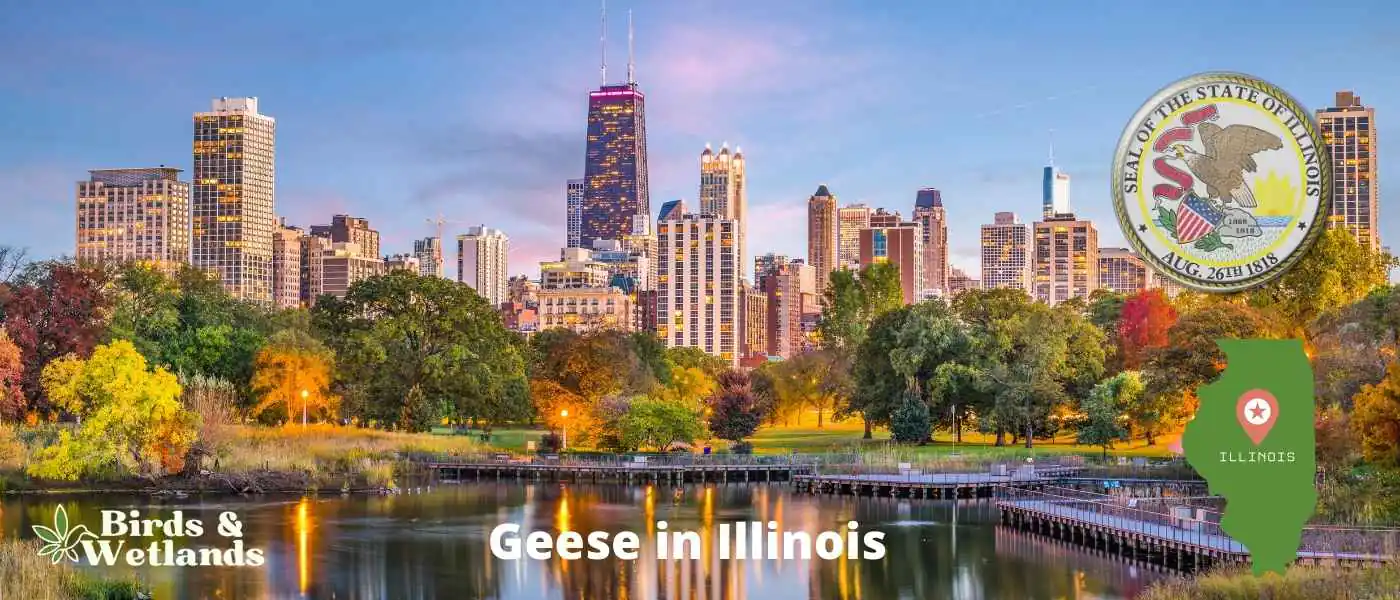If you’re a fan of waterfowl, Illinois is the place to be!
With two major flyways intersecting in the state, it’s a hotspot for bird migration. And one of the stars of Illinois’ avian show is the Canada goose.
These majestic birds can be found in large numbers all across the state, from Chicago’s downtown parks to rural areas near the Mississippi River.
What Geese Are in Illinois?
5 goose species call Illinois home. These geese include:
| Goose | Frequency in Illinois | Resident Population | Specific Locations in Illinois |
|---|---|---|---|
| Canada Goose | Very Common | Yes | Chicago Botanic Garden, Montrose Harbor |
| Snow Goose | Common during migration | No | Emiquon National Wildlife Refuge |
| Ross’s Goose | Less Common | No | Mississippi River near Quad Cities |
| Cackling Goose | Common during migration | No | Chautauqua National Wildlife Refuge |
| Greater White-fronted Goose | Less Common | No | Hennepin & Hopper Lakes State Natural Area |
Additionally, Illinois is the home of 3 swan species – Tundra Swan, Trumpeter Swan and Mute Swan.
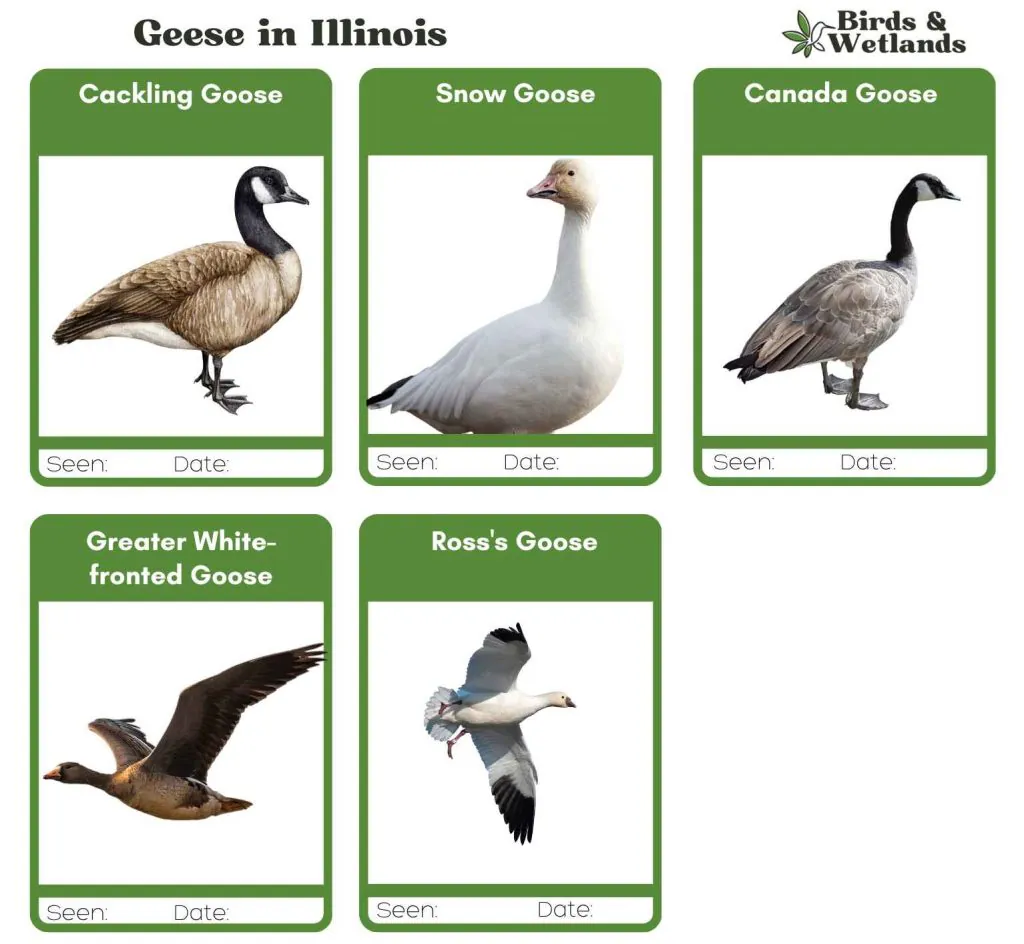
Canada Goose
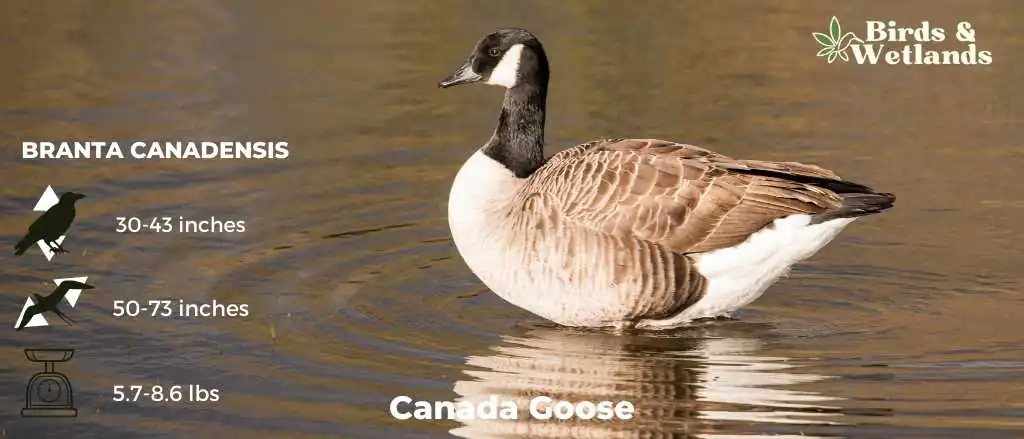
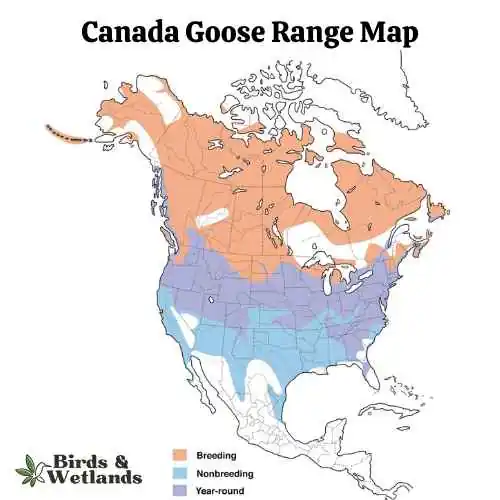
Canada Goose Sound
Scientific Name: Branta canadensis
Length: 30 to 43 in
Wingspan: 50–73 in
Weight: 5.7–14.3 lb
The Canada Goose is a large, well-known species of waterfowl noted for its distinctive appearance, familiar “honk,” and migratory behavior.
Appearance: Both male and female Canada Geese have a similar appearance, featuring a black head and neck with distinctive white patches on the cheeks and chin. The body is primarily brown with a lighter, often white, underbelly.
Diet: Canada Geese primarily feed on plant matter, including grasses, aquatic vegetation, and grains. They can often be seen grazing in parks, lawns, and fields, as well as dabbling in water bodies.
Reproduction: Canada Geese typically nest on the ground near water bodies, often on islands or other isolated areas to avoid predators. The female lays a clutch of about 4 to 6 eggs, which she incubates alone for around a month.
Illinois hosts two distinct Canada Goose populations: year-round temperate-breeders and migratory Interior Canada Geese from Hudson Bay. Winter distributions have shifted north, with more Interior Canada Geese wintering in Illinois, leading to a rise in the local population and potential human-goose conflicts. Remember don’t feed geese and to deter geese away, its best to frighten geese with noise.
Giant canada geese are resident in Illinois all year round and the Illinois department of Natural resources has some concerns about canada goose populations which they are aiming to control, particularly the giant canada goose.
Snow Goose
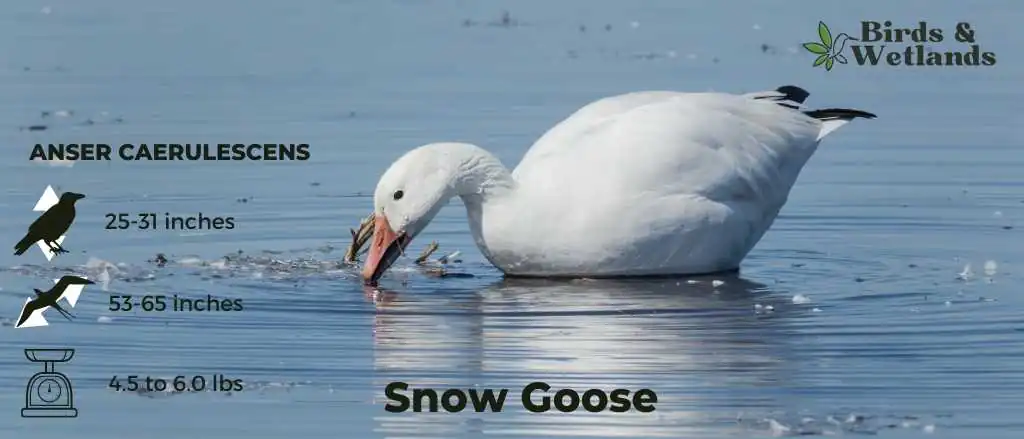
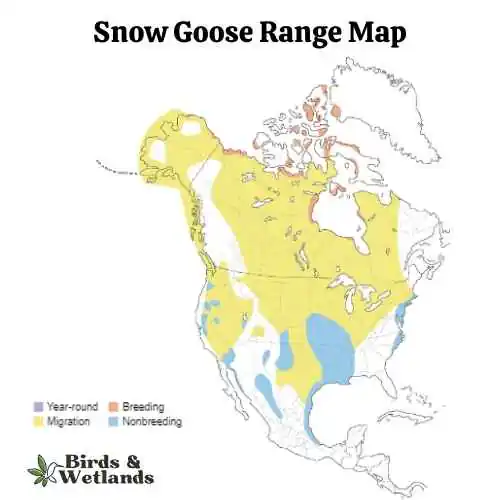
Snow Goose Sound
Scientific Name: Anser caerulescens
Length: 25 to 31 in
Wingspan: 53 to 65 in
Weight: 4.5 to 6.0
The Snow Goose is a large species of waterfowl known for its vibrant white plumage and significant migratory flights.
Appearance: True to their name, Snow Geese are predominantly white with black wingtips. They also have a pink bill, pink legs and feet. A color morph, known as the “Blue Goose,” displays a bluish-gray body with a white head, but is considered the same species.
Diet: Snow Geese primarily feed on plant matter, such as grasses, sedges, and small grains. They can often be seen in large flocks foraging in fields and marshes, and during migration and winter, they can cause considerable damage to agricultural fields due to their feeding habits.
Reproduction: Snow Geese typically nest on the tundra, near water bodies. The female builds the nest and lays a clutch of about 3 to 5 eggs, which she incubates alone for approximately three weeks. Once hatched, the goslings can feed themselves but stay with their parents for protection until they can fly.
In Illinois, you might see Snow Geese in the colder months as they travel south. They are particularly fond of wetlands, lakes, and fields where they forage for food. One of the best times to see them is during their migrations in the spring and fall when large flocks of Snow Geese can sometimes be observed in Illinois’ natural areas.
Ross’s Goose
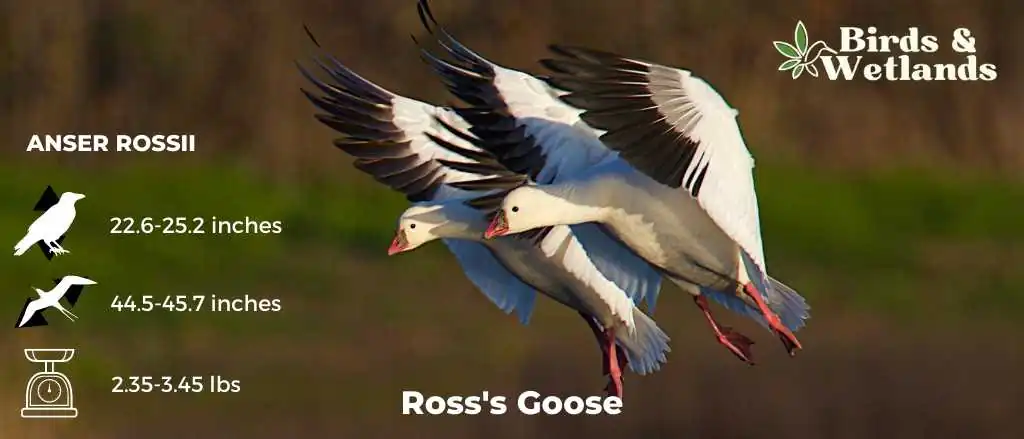
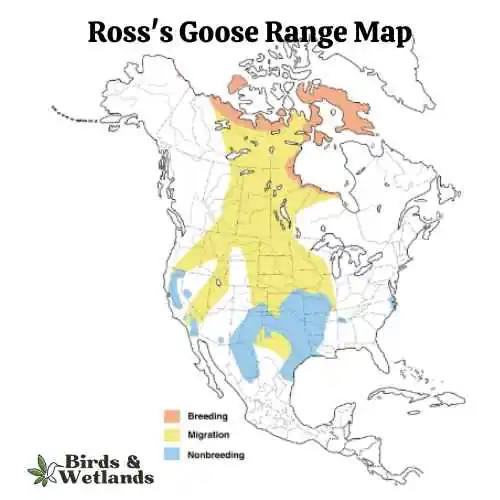
Listen
Scientific Name: Anser rossii
Length: 23.2-25.2
Wingspan: 44.5-45.7 in
Weight:42.3-55.3 oz
The Ross’s Goose is a small species of waterfowl often found in North America’s tundra and wetland habitats.
Appearance: Known for its compact size, the Ross’s Goose is mostly white with black wingtips. It features a short, stubby bill and a rounded head. One key identifying feature is the blueish gray base of its bill, which has a warty structure during the breeding season.
Diet: This goose feeds mainly on vegetation, including seeds, leaves, and roots of grasses and sedges. During winter and migration, they also consume grains and seeds from agricultural fields.
Reproduction: The Ross’s Goose nests on the ground, often in colonies. The female lays a clutch of 2 to 5 eggs which she incubates for around three weeks. The young geese, known as goslings, are precocial – they can walk, swim, and feed themselves shortly after hatching, although they stay with their parents until they learn to fly.
Ross’s Geese, similar to Snow Geese, migrate through Illinois in the spring and fall. They frequent the same wetlands, lakes, and fields, including places like the Mississippi River and Emiquon National Wildlife Refuge. Their presence in Illinois is often less frequent and in smaller numbers compared to Snow Geese. Ross’s Geese look similar to Snow Geese but are noticeably smaller and have a shorter, stubbier bill.
Cackling Goose
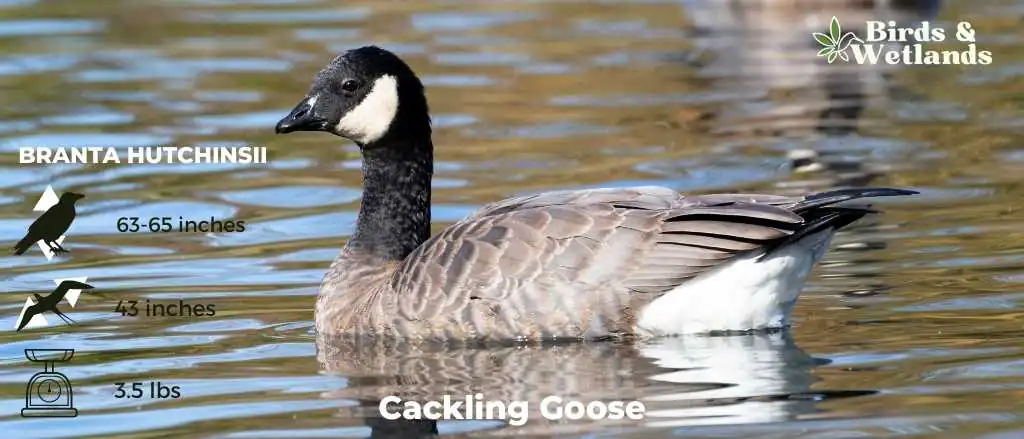
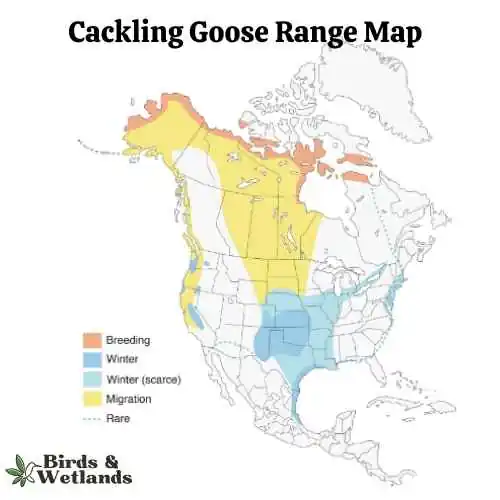
Listen
Scientific Name: Branta hutchinsii
Length: 24.8–25.6 in
Wingspan: 43-45.7 in
Weight:3.5 lbs
Cackling Geese are particularly known for their high-pitched, cackling calls, which is the source of their name. Despite their small size, these geese are renowned long-distance migrants, with some populations traveling thousands of miles between breeding and wintering grounds.
Appearance: With a similar color pattern to the larger Canada Goose, the Cackling Goose features a black head and neck, white chinstrap, light tan to cream chest, and brownish-grey body. One defining characteristic is its noticeably smaller size and stubbier neck compared to its larger counterparts.
Diet: Like many geese, the Cackling Goose’s diet mainly consists of plant matter. This includes grasses, seeds, and aquatic vegetation. They are often seen grazing on land or dabbling in shallow water.
Reproduction: Cackling Geese usually nest on the ground in elevated areas near water bodies, such as riverbanks or lakeshores. The female lays a clutch of 2 to 8 eggs and is responsible for incubation, while the male stands guard nearby. Incubation lasts for about a month.
The Cackling Goose is a notable presence in Illinois, especially during migration periods in spring and fall. Habitats are primarily wetlands, rivers, and agricultural fields. Changes in Illinois climate and land use patterns have impacted these geese, leading to adjustments in their migration timing and routes.
While typically transient, there are increasingly frequent reports of year-round residency, possibly due to milder winters and ample food resources. They’re an important component of Illinois’ biodiversity, and monitoring their numbers aids in understanding local ecosystem health. However, they can pose challenges for farmers due to their feeding habits.
Greater White-fronted Goose
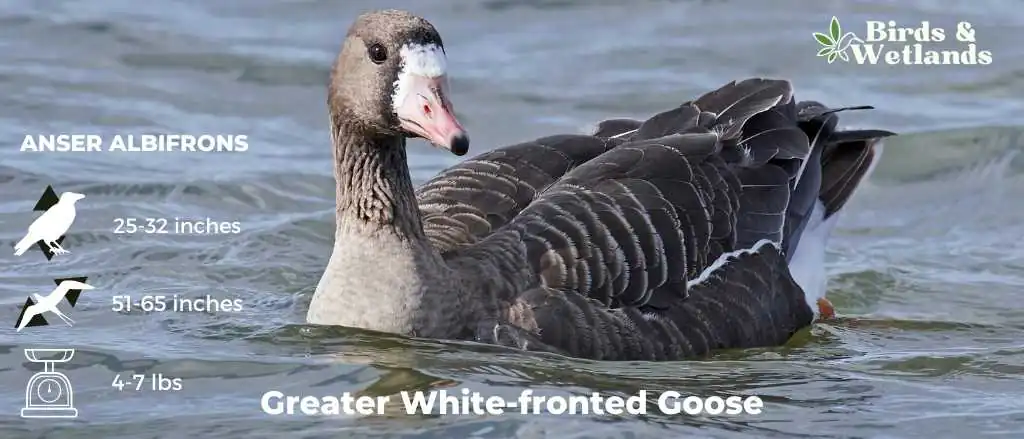
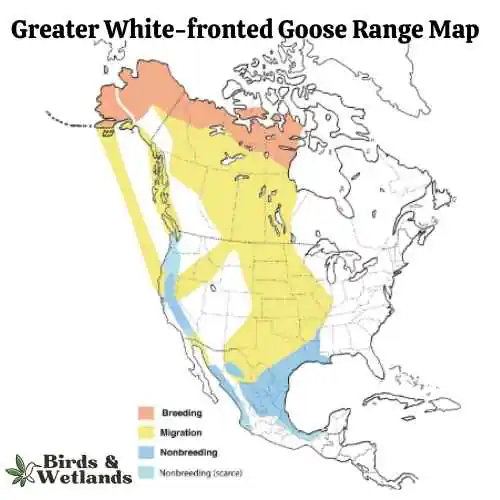
Listen
Scientific Name: Anser albifrons
Length: 25 to 31 in
Wingspan: 53 to 66 in
Weight: 3.3 to 6.6
The Greater White-fronted Goose is a medium to large waterfowl species, widely distributed across the Northern Hemisphere, particularly in North America.
Appearance: As the name suggests, these geese display a prominent white patch at the base of their bill. Their bodies are gray-brown, and their breasts are often marked with dark blotches. They possess a pinkish bill and orange legs and feet.
Diet: The Greater White-fronted Goose is a herbivore and feeds mainly on plant material. Its diet consists of grasses, sedges, grains, and berries. When wintering, these geese can often be found in agricultural fields, feasting on leftover grains and crops.
Reproduction: This species nests on the ground, often in areas with good visibility such as slopes or ridges. The female lays a clutch of 4 to 5 eggs, which she incubates for nearly a month. Once hatched, the young ones are taken care of by both parents until they are able to fly.
The Greater White-fronted Goose frequents Illinois during its migration, providing a seasonal spectacle for bird watchers. Its presence, largely in wetlands and agricultural fields, is most noticeable in spring and fall.
Changes in Illinois’s environment have subtly affected migration schedules, with some birds arriving earlier or departing later. Occasionally, there are reports of these geese overwintering, likely due to warmer winters and sufficient food supplies.
Does Illinois Have a Resident Goose Population?
Canada geese are a common sight in Illinois, and every year, thousands of these birds migrate to the state in search of food and shelter. While some Canada geese do remain in Illinois year-round, the majority of the population is only present during the warmer months.
However, there is evidence that the number of resident geese is on the rise. In recent years, sightings of Canada geese in Illinois have become more and more common, even during the winter months.
This increase in the resident goose population may be due to a variety of factors, including changes in migration patterns and an abundance of food and water resources.
Where to Spot Illinois Geese?
There are numerous natural areas in Illinois where you might spot Geese – especially during their migration. These areas often include wetlands, lakes, and fields where the geese can forage for food. Here are some of these natural areas you might consider:
- Mississippi River: The Mississippi River serves as a significant migration corridor for waterfowl, including Snow Geese. The Upper Mississippi River National Wildlife and Fish Refuge is a great place to watch them.
- Emiquon National Wildlife Refuge: Located in Fulton County, this refuge is one of the largest floodplain restoration projects in the Midwest and attracts many migrating birds.
- Chautauqua National Wildlife Refuge: This refuge, located on the Illinois River, provides an important stopover for migrating waterfowl.
- Hennepin & Hopper Lakes: Part of the Wetlands Initiative’s Dixon Waterfowl Refuge, these restored wetlands in Putnam County are a hotspot for waterfowl.
- Chain O’Lakes State Park: Located in the northeastern part of the state, this park consists of several lakes and marshes that provide habitat for a variety of waterfowl.
- Crab Orchard National Wildlife Refuge: Situated in the southern part of the state, this refuge is home to several bodies of water, attracting a plethora of waterfowl.
- Horicon National Wildlife Refuge: Although technically in Wisconsin, this massive refuge is not far from the northern border of Illinois and is one of the best places in the Midwest to see migrating waterfowl.
Hunting Geese in Illinois
If you want to hunt waterfowl in the state of Illinois, you need to be in possession of an electronic state waterfowl stamp and a federal waterfowl stamp.
Can You Hunt Geese in Illinois?
Yes, you can hunt geese in the state of Illinois provided you have the correct permits and stamps. Additionally, you need to be aware of Illinois’ daily bag and possession limits for geese which are as follows (during the regular season):
Canada Goose – daily bag of three (3) with a possession limit of nine (9).
White-fronted Goose – daily bag of two (2) with a possession limit of six (6)
Snow Goose – daily bag limit is 20 birds, with no possession limit (during the fall and winter season)
Where to Hunt Geese in Illinois?
If you’re looking for spots to hunt geese in Illinois, there are a few places you can check out. One option is the Mississippi Flyway, which extends from Minnesota to Mississippi and is a popular spot for migrating waterfowl.
When Is the Goose Hunting Season in Illinois?
The goose hunting season in Illinois usually starts in the month of October. The state developed a five-year plan in 2020 and implemented starting in 2021. You can read the full hunting season of the state of Illinois here.

